|
|
|

|
Segment - Line Segment
A line segment is the finite piece of line that connects two points in space.
 |
|

|
|
|
|

|
Semiannual
A term often used in Algebra money problems, semiannually means twice a year.
For information on how to solve compound interest problems, check out my lessons on Exponentials and Logarithms. |
|

|
Sequence
A sequence is a list of numbers that typically changes according to some sort of pattern.
A finite sequence example: 1, 3, 5, 7, 9
An infinite sequence example: 1, 4, 9, 16, 25, ...
For more info on sequences, check out my lessons on Sequences & Series. |
|

|
Series
A series is the sum of a sequence.
Example: 1 + 3 + 5 + 7 + 9 = 25
For more info on sequences, check out my lessons on Sequences & Series. |
|

|
Set
A set is a group of objects:

 |
|

|
Similar Triangles
Similar triangles are triangles whose corresponding angles are congruent and whose sides are proportional (see the equivalent fractions to the right).
 |
|

|
Sine
From trigonometry, the sine of an angle (in the picture below) is the ratio of the opposite side to the hypotenuse:

For more trig info, check out my reference sections on The Trigonometry of Circles and The Trigonometry of Triangles. |
|

|
|
Slope of a Line
Basically, the slope of a line tells us how steep a line is and whether it's going up or down (increasing or decreasing). The slope is found by looking at the rise over therun.

For more specific info on how to find slopes, check out my Algebra lessons on lines.
|
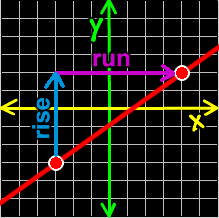
|
|
|

|
|
Snub Cuboctahedron
The snub cuboctahedron is created by either truncating (cutting off) tips
of the cube or the octahedron.
Properties of the snub cuboctahedron
38 total faces: 32 equilateral triangles and 6 squares
24 vertices where each is 4 triangles and 1 square
60 edges
Dihedral angle: 142 degrees, 59 minutes for the sqr-tri angle and
153 degrees, 14 minutes for the tri-tri angle
For more info about polyhedra, check out my Platonic solids gallery.
|
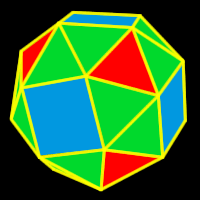
|
|
 |
|
Snub Icosidodecahedron
The snub icosidodecahedron is created by either truncating (cutting off)
the dodecahedron or the icosahedron.
Properties of the snub icosidodecahedron
92 total faces: 80 equilateral triangles and 12 regular pentagons
60 vertices where each is 5 triangles and 1 pentagon
150 edges
Dihedral angle: 152 degrees, 16 minutes for the pent-tri angle and
164 degrees, 11 minutes for the tri-tri angle
For more info about polyhedra, check out my Platonic solids gallery.
|
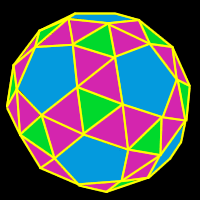
|
|
|

|
|
Sphere
A sphere is a three dimensional circle. Imagine putting a line through the widest part of a circle and spinning it. This would give you a sphere.
|
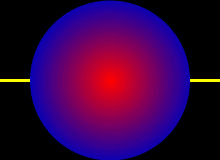
|
|
|

|
|
|
|

|
Square Numbers
A square number is the answer when you take an integer and multiply it to itself:

Here's a partial list of square numbers:
0, 1, 4, 9, 16, 25, 36, 49, 64, 81, 100, 121, 144, ... |
|

|
Square Root
Here is how we write a square root... It's made up of a radical sign and something inside called the radicand.

The square root of a number (the radicand) is a number that produces the radicand when it is squared.
Example:

To learn more about radicals, check out my Radicals Review lesson. |
|

|
Subset
A subset is a set whose members are part of a bigger set.
Example: The set B is a smaller set whose members are part of the bigger set A:

Here's how we write it...
The "U" lying on its side is the symbol for "is a subset of." 
So, this says that the set B is a subset of the set A. |
|

|
Subtrahend
When you do a subtraction problem, the subtrahend is the number you are taking off:
8 - 5 = 3
For more info, check out my Subtraction Lessons. |
|

|
Sum
In an addition problem like 2 + 3 = 5, the sum is the answer.
For more info, check out my Addition Lessons. |
|

|
Summation
A summation is a fancy notation to represent a series (a list of things that you want to add together.)
Here's an example:

The complete description is pretty long... If you want more than this, check out my Summations Algebra Lesson on Sigma Notation. |
|

|
|
Supplementary Angles
In the picture on the right, angles A and B are supplementary angles because their measures add up to 180 degrees:

|
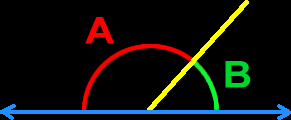
|
|
|

|
|
Supplement of an Angle
Working from the idea of supplementary angles in the definition above this, the supplement of an angle B is whatever size is necessary so that, if you stick the two angles together, they make a 180 degree angle.
To find the supplement of an angle, just subtract from 180...
Example: Find the supplement of angle B whose measure is 40 degrees:
180 - 40 = 140... So, the supplement is 140 degrees. Easy!
|
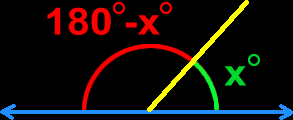
|
|
|

|
|
Symmetry
Having symmetry (or being symmetric) means that something is a mirror image over a line in space. Look at the picture on the right... The left halfis a perfect mirror image of the right half over that yellow line. (Ignoring the color difference, of course.)
You can say that this image is symmetric with respect to the line... Or you can say that this image is symmetric over the line (more casual). The line is called the axis of symmetry.
|
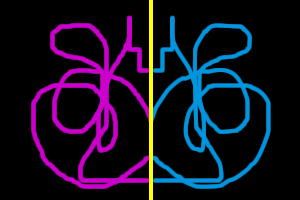
|
|
|

|
System of Equations
A system of equations is when you have more than one equation AND more than one variable to solve for (the unknowns).
Example: 2x - 5y = 22
7x + 3y = -5
For information on how to solve systems of equations, check out my Systems of Equations Lessons for 2x2's and mySystems of Equation Lessons for 3x3's. |

